Dining in Seattle 2022
I spent a few weeks in Seattle for my daughter’s wedding. With the bride and groom working at professional jobs and I being lodged in an Airbnb, we had little time to prepare proper meals. We threw together quick grilled or stir-fried food, ordered take-out, and also ate at restaurants, sometimes together or just by myself. For some of these visits, Natasha and Josh contributed their reviews of the meal.
During my visits to Seattle over the years, I have noted that the seafood and produce are fresh, plentiful, and varied. The region is also not lacking in excellent local wines, beers, and ciders. Moreover, there is an abundance of ethnic and creative cuisines. I thought to write a brief account of my culinary adventures during this visit.
West Seattle
My favorite destination for fresh, wholesome food was Seattle Fish, a five-minute walk from my lodgings. It is a fish market with a few tables indoors and outdoors that promises to provide “100 percent sustainable seafood, wild and fresh as the seasons allow, from the docks to your door”. It lives up to its advertising. On several visits, I tried all of its excellent chowders, Clam, Smoked Salmon, and Crab, either in-house or as take-out. The bowl size of the Clam and Smoked Salmon was enough for a meal, thick with seafood, potatoes, celery, and other vegetables, but the Crab was lighter in a creamy tomato soup. For the fish in “fish and chips”, they offered Cod, Salmon, and Halibut. On this trip, I had Halibut. The batter was made with milk, eggs, and Panko. The fillet was firm and meaty, slightly sweet, made complex with a squeeze of lemon, and the accompanying chips were well-browned and crisp.
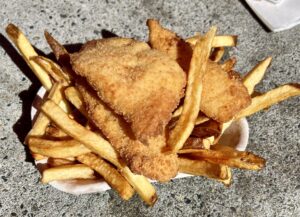
Sun Fish: Cod and Chips
I was told that Sun Fish on Alki beach nearby offered equally good fish and chips. It was an even simpler place with uninviting indoor Formica and outdoor concrete tables shaded by umbrellas. Two old geysers served me a few pieces of cod and chips with packets of tomato and tartar sauce, and I had to ask for wedges of lemon. The cod was moist, but the batter easily separated from the fish, making it awkward to get the combined flavor, although the chips were fine. The meal was definitely not as good as Seattle Fish.
I often walked along Alki beach on sunny mornings before it became uncomfortably hot. On one such morning, I had brunch with my daughter and ex-wife at Harry’s Beach House, a small restaurant with a rustic interior, a covered patio where we sat, and a few outdoor tables on a side street. I had eaten dinner there a few years ago. On this visit, I ordered, “The Barber”, which had white corn grits, mushrooms, and braised greens placed on a spread of harissa sauce and topped with two perfectly poached eggs and a sliced half avocado. The combination seems odd, but it worked well when the subterranean harissa sauce was mixed in to lend it a unifying flavor that, surprisingly, brought forth the sense of the other ingredients.

Harry’s Beach House: The Barber
By reputation, Il Nido is the fancy restaurant along Alki beach, so popular that my daughter had to make the reservation a month in advance. It was a James Beard Foundation Semi-Finalist for the best new restaurant in 2020. Housed in a modernized century-old log cabin with wood floors and tables, gives it a feeling of a home. Because of its reputation, Natasha, Josh, and I ordered two courses each, unusual for us. By consensus, the oil-poached flakes of Albacore Tuna with escarole, radicchio, pickled carrots, radish, and caper berries in a white balsamic, crème Fraiche dressing was the best starter. The vegetables were fresh from the farm and the tuna absorbed the dressing’s delicate flavor. The soft creamy Burrata, stone fruit, basil, cucumber, and blackberry, in fig leaf oil was surprisingly light with a standout dressing, but disappointingly, no bread was offered to soak up the remnants. The Fettuna, a fancy toast, topped with heirloom tomatoes and nectarines was light, sweet, and savory.

Il Nido
I broke my pescatarian diet for the main course and had the Busiat, a wild boar Tuscan Ragu with Parmesan. It did not disappoint. It tasted like the one I had in Bologna years ago and made many times using Marcella Hazan’s recipe, which required simmering in milk and wine successively, taking hours to prepare. But the long semolina macaroni it was served over was underdone and chewy and did not absorb any of the Ragu. I left it aside and ate just the excellent sauce. Josh had the Lumache, tender ridged shells in a strong, but not overwhelming, anchovy and garlic-lemon sauce. Natasha’s Mafalde had long pasta noodles with ribboned sides, like lasagna, served in a broccoli cream sauce with a hint of lemon. It was light and refreshing for a hot summer day. The service was attentive, although it took a while for antipasti to arrive.
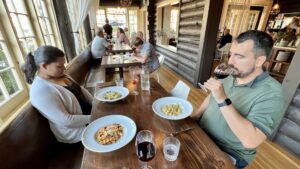
Il Nido: Covered Porch
We ate at Jak’s Steak House in the neighborhood as our post-wedding final outing before I left for Washington DC. After a couple of substantial wedding meals, we had just a main course and shared a dessert. I had the Mushroom and Asparagus Risotto, which was not bad for a steak house. The vegetables had some bite to them and the viscous rice was well-done, but could have used more Parmesan and fresh ground pepper, which was not available.
Natasha had an 8oz filet minion, a staple of the restaurant. It was cooked more rare than the medium-rare that was requested, but it was tender and melted in her mouth. The accompanying garlic mashed potatoes never fail to disappoint her, perfectly complementing the dish. Josh ordered a 12oz New York strip steak with garlic mashed potatoes and broccoli. The steak was cooked perfectly medium-rare and it was mouthwateringly good, the mashed potatoes were the right consistency and delicious, but the broccoli was a little undercooked for his liking.
Natasha noted that every time they dine at Jak’s, the restaurant has a different New York Style Cheesecake. Although she dreamed of the key lime version featured last year, the Oreo Cheesecake did not disappoint. It was slightly tart and not too creamy. One slice was a perfect size for us to share.
I sampled several of the many Asian restaurants in West Seattle. Oh’s Sandwich serves Bahn Mi from a hole in the wall, usually with a line of customers outside at lunchtime. It offers various types of meat and tofu, but no seafood. As a pescatarian, I was restricted to tofu. My sandwich had fried tofu, pickled carrots, cucumber, and daikon (pickled radish) with a soy-based sauce in a small baguette. It was substantial and unwieldy, made easier by slicing it into pieces at home. The sauce had a mild flavor, which I embellished with some chili sauce. At Dumplings of Fury, an ominous name, I took out an order of Tofu Bao, fried tofu, pickled red ginger, green onions, cilantro, and hoisin sauce in soft buns. The sandwich had varied tastes, depending on which ingredient in the bite dominated, but none were “furious”.
From Ka Pow Thai Virtual Kitchen (shared with other vendors) I had a take-out order of seafood over rice with stir-fried shrimps, squid, scallops, and mussels, all in substantial numbers, enough for two meals. The distinctive taste of fried holy basil, with hints of clove, black pepper, and lemon made this meal the closest in taste to those I have had in Thailand. At Srivilai Thai, the fried rice with onions, peas, tomatoes, carrots, eggs, and tofu at number 2 of 5 levels of heat, was satisfying and sufficiently hot. Similarly, Bangbar offered combinations of ingredients in a variety of sauces with noodles or rice. I had the peanut-based, creamy Massaman curry with vegetables and tofu, nice enough, but did not arouse my tastebuds much.
Seattle
Cedar is near the University of Washington campus, which my daughter attended. I have eaten there several times in the past decade. Despite its name, it serves authentic Indian food. On my first visit, I was surprised at how good the Aloo Gobi (potatoes and cauliflower) tasted, so I always order that. With three of us dining this time, we also ordered Eggplant Bharta, Paneer Butter Masala, Raita (yogurt with pieces of onion and cucumber), Rice, and Garlic Nan. The Aloo Gobi was as good as I remembered, the Eggplant had the slightly burnt aftertaste that it is supposed to, butter sauce with the Paneer was thinner than I prefer. The portions were large enough to provide us with another meal.
Fuji Sushi is in the erstwhile Japanese section of the International District. Local friends introduced me to it on my last visit. I ordered the Bento Box as before with miso soup, salad, rice, vegetable and shrimp tempura, salmon teriyaki, and ginger tofu. The miso soup was thicker and creamier than normally served in Japanese restaurants and the tofu cubes in it were more plentiful. The good-sized portion of salmon came in a mild teriyaki sauce; the large cubes of lightly braised tofu with filings of ginger were in a soy-based sauce; and a few pieces of tempura (one shrimp, one sweet potato, one zucchini in thicker than usual batter) and two pot stickers. Except for tempura, the food was of good quality, a standard, but unexceptional meal.

Fuji Sushi: Bento Box
Tamarind Tree is further up the hill in the International District where it takes on more of a South East and East Asian flavor. I had eaten at Tamarind Tree a couple of times on previous visits. That most of the clientele is still Vietnamese was reassuring. I had the Tamarind Tree salad roll with lightly fried tofu and fresh veggies wrapped in rice paper with a dipping sauce, which lent some taste to it. The Tamarind Tree Crepe with shrimp and calamari, mostly the latter, was crisp and covered with lots of beansprouts. It was a big dish, but quite bland and oily, and needed chili sauce to give it flavor. I thought I was safe ordering the restaurant’s signature dishes, but the meal, while filling, was not satisfying.
If Michelin rated restaurants in Seattle, Canlis would certainly be a contender for stars. Opened by the Canlis family in 1950, it has since been a top-rated restaurant. It is located on a hill in the Queen Anne district of Seattle in a modernized building that has floor-to-ceiling glass in the dining room with a view of the city and the Cascade mountains. The cuisine’s Hawaiian and Japanese influences come from earlier ventures in the islands. A valet took our car from the porch and we stepped through an imposing heavy wood door into the dining area, and were chaperoned to our table.
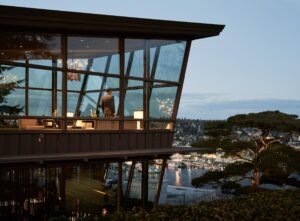
Canlis View
The restaurant offers a three-course pre-fixe menu with options in each course to cover dietary preferences. Before the first course, we were offered three small bites consisting of Kampachi, Chawanmushi, and Spot Prawn. The sliver of Kampachi, a marine sushi grade fish, was aged and cured in salt, served with a slice of Kohlrabi (cabbage) and Shiso (a herb with a mint-like flavor); the Chawanmushi was an egg custard with smoked mushrooms, Tamari soy sauce, mushroom dashi, and maple syrup; and the Spot Prawn was served with hard-boiled egg, avocado emulsion, and thousand island dressing powder. It turned out that these small dishes were the best part of the dinner.
My first course was an Eggplant Zurita, a small piece of a Chinese eggplant omelet with oyster and nori (seaweed) topped with a spoon of caviar, a creation of the executive chef, Aisha Ibrahim’s mother. The unusual combination of eggs and eggplant aroused my tastebuds initially, but it was the salty flavor of the caviar that lingered.
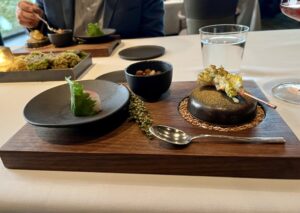
Canlis Starter Trio
Natasha had the Halibut for her main course. The server placed a bowl containing a par-baked filet topped with geoduck in front of her and poured hot dashi, a broth commonly used as the base for miso soup, over the filet, and she was instructed to allow it to cook a little more in the broth. While the fish was perfectly cooked, she thought it lacked the flavor she was expecting, especially considering it had been soaking in broth. Josh got the filet mignon, which came medium cooked, and was fine. While it was lean, tender, and buttery, he was surprised that the waiter did not ask how he liked his steak. My Salmon’s inner flakes were pink, just how I like it, but the parsnip in a ginger sauce did not enhance the taste much. Perhaps it was the excellence of the first three small bites that set the bar too high for the subsequent courses.

Canlis Salmon
My dessert was a dark chocolate sorbet with koji, a citrus-tasting natural sweetener, spruce tips, and strawberries. It was light and its blend of flavors was a fitting close to a pleasant meal.
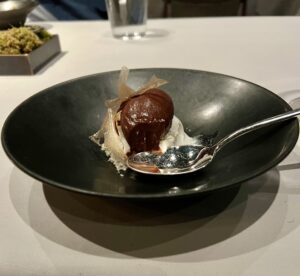
Canlis Dessert
The 90-page wine list was intimidating and more expensive than other equivalent restaurants. Natasha and I had a glass of Trollinger and Friends Rose, a light, aromatic wine from Germany, and I also had a fruity Pinot Noir made by Zweigelt from Austria. Josh had a dark, full-bodied beer with his steak.
It was an enjoyable meal in a pretty setting, but I can’t say that it matched the quality of food at other Michelin-starred restaurants I have dined at even though the service was superb– efficient, attentive, and certainly deserving of accolades.
.
